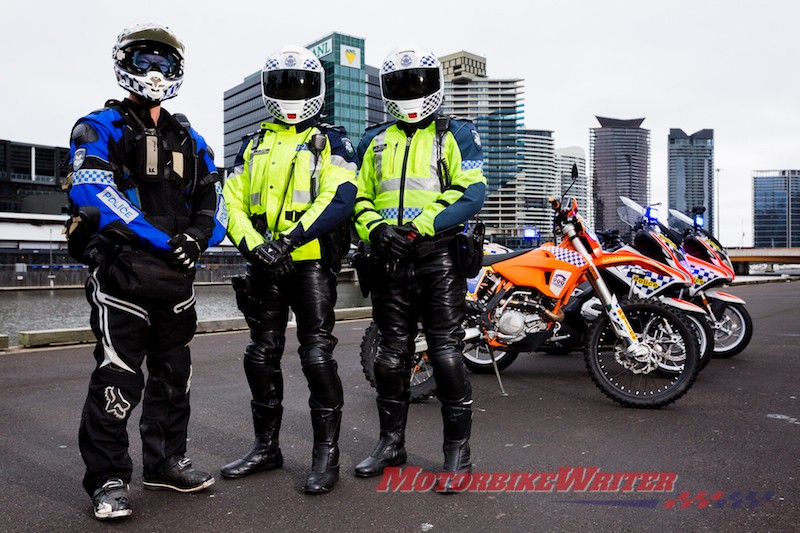Learner riders in Victoria will cop one demerit point for not wearing a hi-vis vest from 29 October 2019 under new road rules.
The Victorian Motorcycle Council had called to remove mandatory hi-vis vests for learner riders in its 10-page submission to the review of Victorian Road Safety (Driver) Regulations.
However, it has been ignored.
Learner riders had previously only been fined $165.22 for the offence. On average, about 400-500 infringement notices have been issued each year.
Now they cop a demerit point for not wearing an approved hi-vis vest or jacket.
They will also now get one demerit point for not displaying an L plate.
Vest of shame

VMC media spokesman John Eacott says the rider learner permit changes are “unwarranted” and not a safety issue.
“The application of a requirement to have the Vest of Shame (aka the hi-vis safety vest) ‘securely fastened’ becomes a safety issue on hot days as it leads to heat stress and reduced rider competence,” he says.
“This was highlighted shortly before the RIS when the Minister for Roads and Road Safety was shown the testing procedures at Deakin University of garments for MotoCAP.
“It is bizarre to have a requirement for a hi-vis vest for Learners and then demand it be worn in a manner to reduce rider efficiency. This was brought to the attention of the Department of Transport, but appears to have been ignored and not even mentioned in the summary of responses.”
We asked the Department of Transport for the number fines issued since the rule applied in 2014 and what consituted an approved vest/jacket.
No reply has yet been received but we will update if/when they do.
L plate demerit point
The VMC also claim the L plate demerit point is unfair as a plate can easily fall off a motorcycle resulting in a rider losing their licence and their only mode of transport.
“There is no road safety risk or road user behaviour targeted by the sanction, therefore no genuine road safety objective served,” their submissions says.
“A motorcycle is an arduous exposed environment, experiencing vibration, winds, rain, road grime/fumes and sunlight/UV exposure.
“L plates are typically plastic, embrittle with time and are not very resilient to these exposed service conditions.
“As a result, an L-plate may fall off during a ride without the knowledge of the rider since plates are affixed to the rear of the motorcycle.”
Hi-vis mandated
The learner hi-vis rule was introduced in 2014 despite the state government’s road safety committee citing a European road safety research that found the benefits of wearing a high-visibility vest depended on the time of day and location.
Since its introduction, there has been no study into its effect on crashes among learners and the Traffic Accident Commission does not differentiate learner riders in its statistics.
We could not find any similar hi-vis rules throughout the world except France where all riders must have a minimum fluoro requirement on their jackets.
All riders (and drivers) in France must also carry a hi-vis vest and wear it if broken down on the side of the roads.
Most motorcycle police around the world wear hi-vis gear.

However, it didn’t stop this British copper from nearly being hit by a van driver who just didn’t look even though the police officer had hi-vis gear, flashing lights and sirens.
Contrary evidence
University of Melbourne Chair of Statistics and bike rider Prof Richard Huggins has called to remove the rule since it was introduced.
The Prof has reviewed several international studies on motorcycle conspicuity and “look but fail to see” accidents and says there is “sufficient doubt” of the effectiveness of hi-vis to call for a repeal of the mandatory requirement.
He says the studies had varied findings suggesting:
- Dark clothing is more visible in certain lighting situations;
- Hi-vis rider gear may be less visible in certain conditions; and
- Hi-vis clothing could create a “target fixation” for motorists, causing them to steer toward the wearer.
Richard also says he regularly wears a hi-visibility jacket when riding, but has still been hit by a car.
“The driver claimed they didn’t see me, from a distance of less than 2m, as they changed lanes on top of me,” he says.
When the law was introduced, the VMC cited Prof Huggins’s research and objected to the rule on several grounds:
- Wearing hi-vis clothing may impart a false sense of security for novice riders;
- Modern research shows that people don’t recognise or react to motorcycles, rather than not seeing them at all;
- Drivers are more likely to see a bike but make an error in timing;
- All bikes have hard-wired headlights yet no research has been done on how this affects hi-visibility; and
- If hi-vis is a real safety issue, why are there no greater penalties for drivers who crash into people wearing them?
Approved hi-vis
The definition of an approved high visibility vest or jacket is set out in regulation 59 (9) of the revised Drivers Regulations, which states that:
(9) In this regulation, approved high visibility vest or jacket means a high visibility vest or jacket that meets and is labelled or marked to indicate that it meets at least one of the following standards for day and night high visibility garments and apparel—
(a) AS/NZS 4602.1:2011;
(b) ISO 20471:2013 High visibility clothing—Test methods and requirements;
(c) ANSI/ISEA 107-2015 High-Visibility Safety Apparel and Accessories;
(d) BS EN ISO 20471:2013+A1:2016 High-visibility warning clothing for professional use. Test methods and requirements.
These standards incorporate previous standards, so all existing high-visibility vests/jackets allowed under the previous version of the regulations will still be legally allowed to be used.



